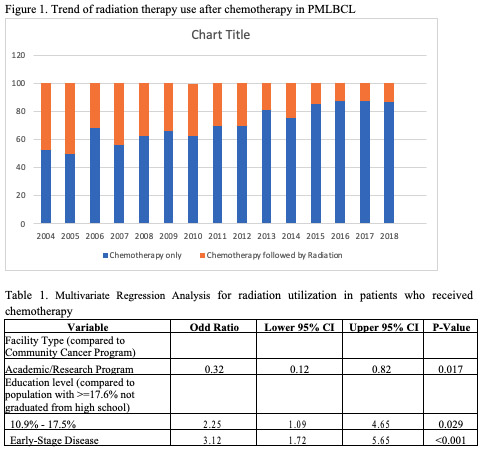Introduction
Primary mediastinal large B-cell lymphoma (PMLBCL) is a rare and aggressive type of non-Hodgkin B-cell lymphoma, accounting for about 3% of all non-Hodgkin lymphomas. The role of radiation therapy following immunochemotherapy is controversial and lately there has been more studies suggesting there is less benefit of adding radiation therapy. Large-scale studies describing and evaluating the effect of radiation therapy on survival outcome are lacking.
Materials and Methods
The National Cancer Database (NCDB) was queried for patients diagnosed with PMLBCL between 2004 and 2019. All patients aged ³18 years diagnosed with PMLBCL were included. We excluded patients with unknown chemotherapy and radiation therapy status, or received radiation prior to chemotherapy, or received radiation 6 months after chemotherapy or lost to follow-up (unknown vital status of last contact). Kaplan-Meier and multivariate Cox regression were used in the analyses.
Results
The total cohort consisted of 1,899 patients with PMLBCL. Out of whom 1,177 (62%) were females, 1,560 (76%) were White non-Hispanic, 113 (6%) were White Hispanic and 205 (11%) were African Americans. Among patients with known disease stage, 1,164 (61%) had early-stage disease (stage I and II) and 351 (19%) had advanced stage disease (stage III and IV). 1,443 (76%) received chemotherapy only and 456 (24%) received chemotherapy followed by radiation therapy. The median age at diagnosis was 35 years (range 18-90), 1,215 (64%) were diagnosed at younger age (40 years or less). The median follow-up time was 60 months (95% CI 57-62), the median overall survival (OS) for the whole cohort was not reached, and the 5-year OS was 91%. The 5-year OS for early and advanced stage were 93% and 83%, respectively.
In patients with early-stage disease, there was no statistically significant difference in the median OS between patients who received chemotherapy only (N=824) compared to patients who received chemotherapy followed by radiation therapy (N=340) (not reached in both groups, P=0.130) with 5-year OS of 92% and 93%, respectively.
In patients with advanced stage disease, there was no statistically significant difference in the median OS between patients who received chemotherapy only (N=294) and patients who received chemotherapy followed by radiation therapy (N=57) (median OS not reached in both groups, P=0.067) with 5-year OS of 82% and 88%, respectively.
On multivariate analysis, older age and Charlson-Deyo score ≥3 were associated with worse OS (HR 1.062 95% CI 1.047-1.078; P<0.001 and HR 6.032 95% CI 1.853-19.634; P=0.003, respectively), early stage was associated with better OS (HR 0.508 95% CI 0.364-0.708; P<0.001), whereas adding radiation to chemotherapy did not affect the OS (HR 0.713 95% CI 0.491-1.035; P=0.075).
Over the years, there was a significant down trend in using radiation therapy (Figure 1).
Using univariate and multivariate logistic regression analysis, we found early-stage disease was associated with increased use of radiation therapy after chemotherapy. Whereas patients who were treated at academic/research programs were less likely to receive radiation therapy (Table 1).
Conclusion
This large real-world analysis shows a practice change in PMLBCL treatment with a trend in omitting radiation therapy. In our analysis, we found that adding radiation therapy to systemic therapy did not affect the survival outcome in both early and advanced stage disease.
Disclosures
Hoppe:Merck SAC for AHOD1822/KN667 low risk: Consultancy. Alhaj Moustafa:CSL Behring: Consultancy; Abbvie: Consultancy; Acrotech Biopharma: Research Funding.


This feature is available to Subscribers Only
Sign In or Create an Account Close Modal